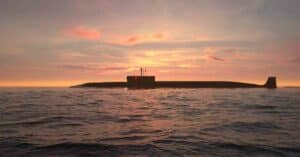
U.S. Navy Ship Stranded In Lake Erie At Cleveland Port Due to Strike By Employees
November 1, 2023
Grounded Cargo Ship Bonnie G Refloated In the Caribbean
November 1, 2023
A reorganisation of the US Navy’s undersea warfare community that started about two years back has reportedly sharpened the focus on developing modern war-fighting tools, including a network of communications systems that will assist joint all-domain operations, a top leader mentioned.

The reorganisation permitted the attack as well as ballistic missile submarine communities to consider the new construction as well as the sustainment of existing boats in a breath instead of treating them as distinct endeavours.
It further built a third program executive office, the PEO Undersea Warfare Systems, to perceive networks, weapons, combat systems, and more that can enable the advanced submarine fleet.
The moves accelerated the undersea portion of the Navy’s Project Overmatch, per Jay Stefany, the acting assistant secretary associated with the service, especially in research, development, and acquisition.
The Project Overmatch is the Navy’s dedication and contribution to the Pentagon’s Joint All-Domain Command and Control vision that would offer several secure ways for communicating between vessels, aircraft, unmanned systems, and ground stations in military campaigns.
Still, the features developed under the initiative continue to be a work in progress.
The first carrier strike group to be deployed with the Project Overmatch capabilities, dubbed the Carl Vinson Carrier Strike Group, which was deployed to the Pacific earlier in October, does not possess such an undersea capability, Stefany mentioned.
However, the next one will, he told the Defense News in an interview held on 23 October.
It is currently in the works. It might not have been as much in the results had they not consolidated the undersea support functions in a single PEO, he said.
He considers it exciting as they march from a minimum viable product to a larger and full-up Project Overmatch.
Stefany said that the new PEO had been collaborating with the PEO for its Integrated Warfare Systems, which manages surface vessel combat systems, for participating in efforts to get more next-gen software delivery, automated testing, and over-the-air software upgrades and updates to the surface vessels as well as submarines.
The new office has created a bold “production mindset” for the Mk 54 and Mk 48 torpedo programs, which Stefany mentioned had been off track.
The organisational changes two years ago have welcomed a bigger awareness of the need for synchronising submarine construction and maintenance plans, he mentioned.
Submarine maintenance, as well as modernisation, had been managed by a different flag officer than the submarine construction in both the attack- and ballistic missile-submarine communities.
This reorganisation permits the latter faction to work out the transition of sustaining Ohio-class boats until the Columbia-class boats go online, which Stefany mentioned is going well.
Stefany said that the reorganisation offers the attack submarine community an opportunity to reform the submarine sustainment efforts that have suffered over the recent years from a sheer lack of parts and delays at the repair yards.
Even as leaders continue to work through the issues, Stefany said that there is a lot more work to be done to bring in a new mentality for sustainment work.
The Navy has been trying to execute its Shipyard Infrastructure Optimization Program for overhauling and modernising public yards.
Once these facilities are enhanced, Stefany mentioned that the Navy would be looking to overhaul this process by which the submarine work has been scheduled, planned, and successfully delivered at the yards to make it further akin to a deal at a private yard that includes cost as well as schedule incentives.
Reference: Defense News
U.S. Navy Submarine Branch Focusing On Developing Project Overmatch appeared first on Marine Insight – The Maritime Industry Guide
Source: Maritime Shipping News


